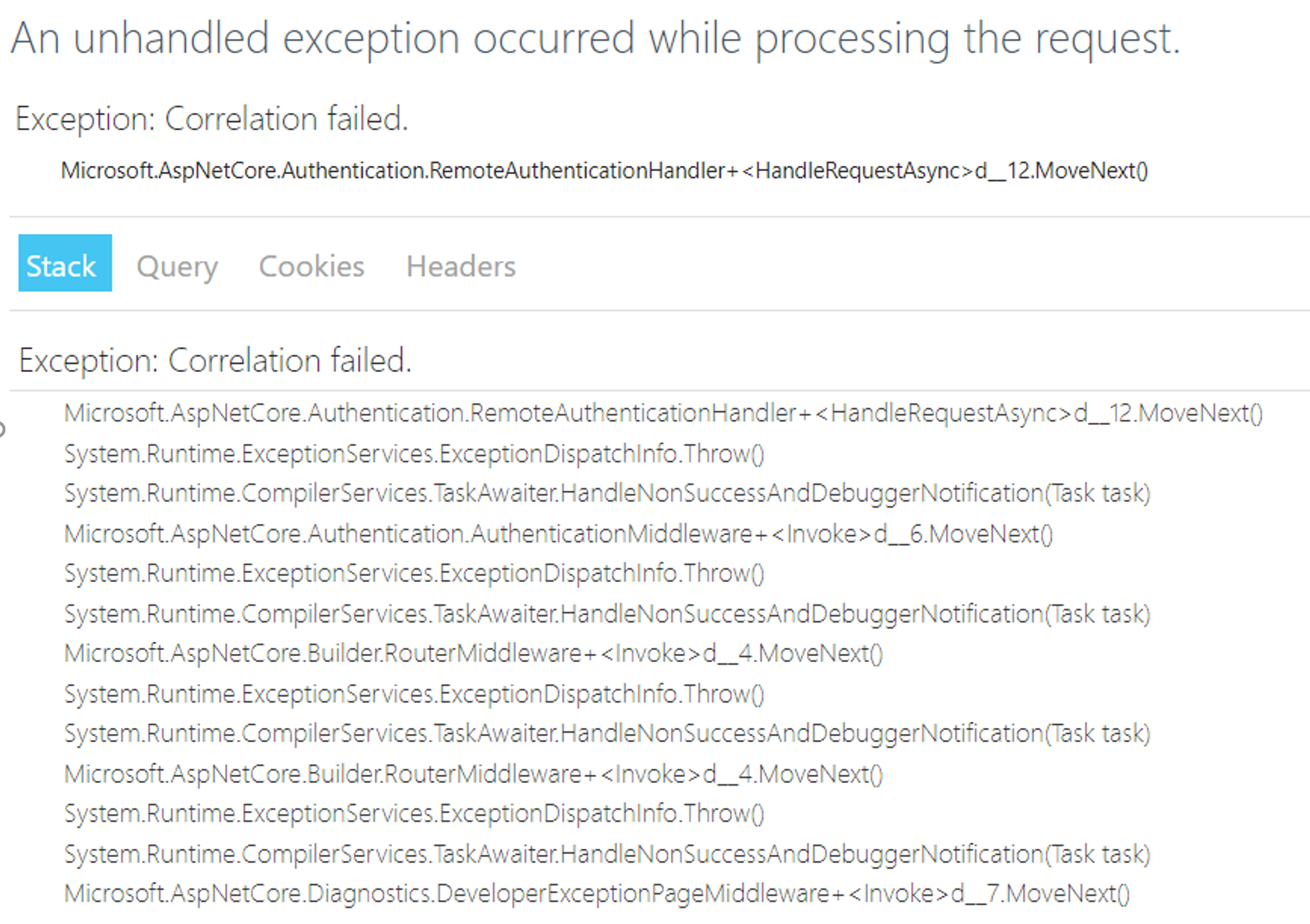Correlation failed. at Microsoft.AspNetCore.Authentication.RemoteAuthenticationHandler during OIDC authentication
I am hitting this with the following combination: 1) Browser incognito mode (Chrome) 2) Application is behind Azure application gateway (no repro if it isnt). Cookie based affinity is turned OFF (default); if turned ON, seems to make repro happen more often.
Code is rather plain vanilla OIDC authN + cookies.
services.AddAuthentication(options =>
{
options.DefaultScheme = CookieAuthenticationDefaults.AuthenticationScheme;
options.DefaultChallengeScheme = OpenIdConnectDefaults.AuthenticationScheme;
})
.AddAzureAd(options => {
Configuration.Bind("AzureAd", options);
})
.AddCookie(p => p.SlidingExpiration = true);
I am forwarding the X-Forwarded-Proto header to the auth middleware as recommended so the redirect_uri uses the correct protocol scheme.
HANDLING IN CODE
I tried to handle the OnRemoteFailure() event, and redirect to "/Home/AuthRedirect" which is an anon page that waits for 20 secs, and then redirects to the "/" (home page). It seems to work sometimes, but not always. I am out of ideas.
WORKAROUND
1) Users can go to the homepage again and hit F5 until this works. It seems that each F5 gets them moving a step ahead and once the OpenID cookies are populated, everything else (I have more auth after openid finishes, via adal.js for AJAX use). 2) Bypass the application gateway and use the direct service fabric cluster DNS name (not acceptable as it is http).
DETAILS
System.Exception: Correlation failed. at Microsoft.AspNetCore.Authentication.RemoteAuthenticationHandler`1.d__12.MoveNext() --- End of stack trace from previous location where exception was thrown --- at System.Runtime.ExceptionServices.ExceptionDispatchInfo.Throw() at System.Runtime.CompilerServices.TaskAwaiter.HandleNonSuccessAndDebuggerNotification(Task task) at Microsoft.AspNetCore.Authentication.AuthenticationMiddleware.d__6.MoveNext() --- End of stack trace from previous location where exception was thrown --- at System.Runtime.ExceptionServices.ExceptionDispatchInfo.Throw() at System.Runtime.CompilerServices.TaskAwaiter.HandleNonSuccessAndDebuggerNotification(Task task) at Microsoft.AspNetCore.Builder.RouterMiddleware.d__4.MoveNext() --- End of stack trace from previous location where exception was thrown --- at System.Runtime.ExceptionServices.ExceptionDispatchInfo.Throw() at System.Runtime.CompilerServices.TaskAwaiter.HandleNonSuccessAndDebuggerNotification(Task task) at Microsoft.AspNetCore.Builder.RouterMiddleware.d__4.MoveNext() --- End of stack trace from previous location where exception was thrown --- at System.Runtime.ExceptionServices.ExceptionDispatchInfo.Throw() at System.Runtime.CompilerServices.TaskAwaiter.HandleNonSuccessAndDebuggerNotification(Task task) at Microsoft.AspNetCore.Diagnostics.DeveloperExceptionPageMiddleware.d__7.MoveNext()

Answer
I had a similar Correlation error in Chrome but not Safari... turns out that when SameSite.None is being used you must run your custom site (even localhost) using https. That solved all my correlation woes.
